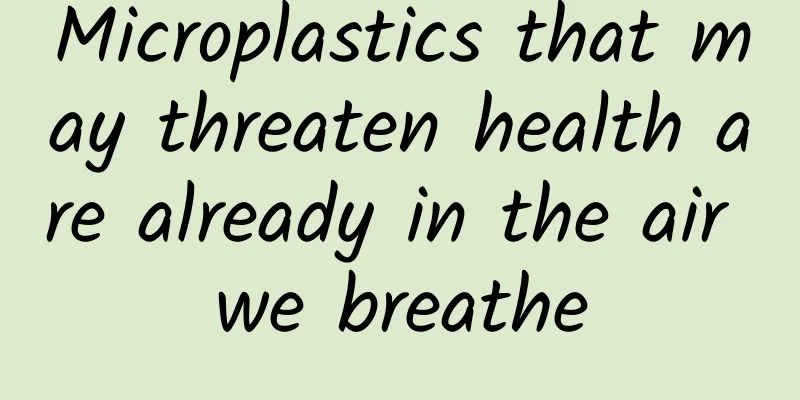Microplastics that may threaten health are already in the air we breathe

|
Microplastics, as the name suggests, refer to extremely small plastic particles, which usually come from the degradation of plastic products or fragments generated during the production process . They can come from plastic bottles, plastic bags, foam and fishing nets, or from plastic microfibers that are difficult to avoid in daily use, and even plastic microbeads added to toothpaste and cosmetics. As plastic waste degrades in the sun, it breaks into smaller and smaller particles. As the use of plastics increases, these tiny plastic particles gradually enter our environment and eventually enter the human body through the air, soil and water . Although the size of these microplastic particles varies greatly, they are usually very small, generally less than 5 mm in diameter, and some are small enough to enter the respiratory tract and even penetrate into the lungs and blood throughout the body . Copyright images in the gallery. Reprinting and using them may lead to copyright disputes. Research on the impact of microplastics on human health is still ongoing, but there is some evidence that microplastics may cause a series of health problems to the human body . On the one hand, microplastics may trigger a response from the immune system, leading to inflammation, and even be associated with some chronic diseases, such as respiratory diseases, cardiovascular diseases, etc. On the other hand, the harm of microplastics is not only reflected in the microplastics themselves, but also in the harmful chemicals they may carry, such as pesticides, heavy metals, antibiotics and pathogenic bacteria, which will be spread in the air, water and soil through microplastics. Additives used in the production of plastics can also have adverse effects on the human body and nature. Once these harmful substances enter the human body, they may cause long-term effects on human and biological health. Microplastics have penetrated every corner —Including the invisible air Microplastics have penetrated into every corner around us. Studies have shown that microplastics are widely distributed in soil, water, atmosphere and organisms. In the soil, microplastics may enter the land through the degradation of discarded plastic products or plastic films used in agricultural activities. Over time, microplastics in the soil may affect the growth of plants and enter animals through the food chain. In water bodies, especially oceans, rivers and lakes, the presence of microplastics is even more serious. Microplastics not only destroy aquatic ecosystems, but can also be mistakenly eaten by aquatic animals, further affecting the safety of aquatic products . Copyright images in the gallery. Reprinting and using them may lead to copyright disputes. In recent years, the issue of microplastics in the air has received increasing attention. The natural degradation of plastic items in our lives, the tiny particles that fall off and break during the use of plastic products such as clothing, car tires, and building materials, can all enter the air and are everywhere in our daily lives. These tiny particles float in the air and can be carried by wind to places far away from the source. Microplastic particles can be transmitted through the atmosphere (wind speed, wind direction, rising or falling air currents, convection, turbulence, etc.) to oceans, glaciers and even remote areas such as the Arctic and Antarctic and the Qinghai-Tibet Plateau far away from human activities, further affecting the widespread distribution of microplastics in land or marine ecological environments. Due to the small size and light weight of microplastics in the air, they can remain suspended in the air for a long time, which greatly expands their spread range and increases the possibility of entering the human body . Microplastics in the air Invisible safety hazards Once microplastics in the air enter the human body, they may cause a series of health problems. First, the microplastic particles themselves may cause physical damage to the respiratory tract . Because these particles are very small, they may penetrate deep into the lungs, causing lung inflammation and tissue damage. Long-term inhalation of microplastics may also affect respiratory function, leading to symptoms such as coughing and shortness of breath, and may even aggravate the symptoms of respiratory diseases such as asthma and chronic obstructive pulmonary disease. Copyright images in the gallery. Reprinting and using them may lead to copyright disputes. What is more serious is that microplastics in the air may carry various toxic chemicals , such as pesticides, heavy metals, polycyclic aromatic hydrocarbons and other harmful substances. Once these substances enter the human body, they may spread to various organs through blood circulation and cause chronic toxic reactions. Scientists have found that some plastic additives such as dyes, plasticizers, stabilizers, etc. have hormone-disrupting effects, affecting the human endocrine system and even causing serious diseases such as cancer. For example, bisphenol A, which is used to produce PC and epoxy resins, has been found to have an impact on endocrine disorders in the human body. In addition, phthalate diesters, which are often used as PVC plasticizers, may shorten the gestation period of pregnant women and reduce the birth weight of infants. In addition, microplastic particles in the air can enter other parts of the human body through the lungs, further causing immune system abnormalities. Studies have shown that microplastics may cause immune responses in the body and stimulate inflammatory responses, thereby increasing the risk of a variety of chronic diseases. Facing microplastics in the air What can we do? What can we do in the face of the increasingly serious and ubiquitous air microplastic pollution? 1 How to reduce the harm of microplastics to us? We can optimize indoor hygiene by regularly sweeping and cleaning the room, and use vacuum cleaners and air purifiers with HEPA filters (High efficiency particulate air filters) to reduce dust and microplastic particles. Using wet cleaning methods (such as wet mops and wet rags) can reduce the amount of dust and microplastics flying into the air during the cleaning process. Studies have shown that in some cities in China, the amount of microplastics indoors is significantly higher than outdoors. Therefore, we can also avoid high concentrations of microplastics in the air by keeping our living and working spaces well ventilated. Regularly opening windows for ventilation can help reduce the accumulation of indoor pollutants. 2 How to reduce microplastic pollution? In our daily lives, we can try to reduce the use of disposable plastic products and try to choose reusable and environmentally friendly alternatives , such as using eco-friendly bags when shopping and bringing our own coffee cups when ordering coffee. When shopping, you can also pay attention to the composition of clothes and try to reduce the use of synthetic fibers . When sorting daily garbage, you can also pay more attention to some plastic recycling , and reduce the accumulation of plastic waste and environmental pollution by rationally sorting and disposing of plastic waste. Of course, efforts are also being made at the national level. Since 2008, China has implemented a "plastic ban" that requires a nationwide ban on the production, sale, and use of plastic shopping bags with a thickness of less than 0.025 mm, and a paid use system for plastic shopping bags in all supermarkets, shopping malls, bazaars and other commodity retail places. In 2020, China introduced a new plastic pollution control policy, expanding the source reduction policy to more disposable plastic products such as the addition of plastic microbeads and the elimination of disposable non-degradable plastic straws. In 2021, China issued the "14th Five-Year Plan for Plastic Pollution Control Action Plan", which focuses on the nature and main contradictions of plastic pollution, further improves the full-chain plastic pollution control system, and clarifies the goals of plastic pollution control by 2025. Microplastic pollution has become one of the major challenges facing the global environment. Microplastics in the air undoubtedly pose a serious threat to our health. Through the joint efforts of individuals and groups in life, we hope to reduce plastic pollution at the source, take effective measures to reduce the concentration of microplastics in the air, and protect the health of humans and ecosystems. References [1]GESAMP, 2016. Sources, fate and effects of microplastics in the marine environment: part 2 of a global assessment. In: IMO/FAO/UNESCO-IOC/UNIDO/WMO/IAEA/UN/UNEP/UNDP Joint Group of Experts on the Scientific Aspects of Marine Environmental Protection. [2]Churg, A., Brauer, M., 2000. Ambient atmospheric particles in the airways of human lungs. Ultrastruct. Pathol. 24, 353–361. https://doi.org/10.1080/019131200750060014. [3]Auta, HS, Emenike, CU, Fauziah, SH, 2017. Distribution and importance of microplastics in the marine environment Li, J., Liu, H., Paul Chen, J., 2018. Microplastics in freshwater systems: a review on occurrence, environmental effects, and methods for microplastics detection. Water Res. Rochman, CM, Tahir, A., Williams, SL, Baxa, DV, Lam, R., Miller, JT, Teh, FC, Werorilangi, S., Teh, SJ, 2015. Anthropogenic debris in seafood: plastic debris and fibers from textiles in fish and bivalves sold for human consumption. Sci. Rep. 5, 1–10. https://doi.org/10.1038/srep14340. [4]DENG Yan-hui, LI Dan, ADYEL TANVEER M, WAN Bing-zhou. Research Progress of Analytical Methods for Microplastics in the Environment. Environmental Monitoring and Forewarning, 2020, 12(5): 31-35. DOI: 10.3969/j.issn.1674-6732.2020.05.004. [5]Allen, S., Allen, D., Phoenix, VR, Le Roux, G., Duranteza, P., Simonneau, A., Stéphane, B., Galop, D., 2019a. Atmospheric transport and deposition of microplastics in a remote mountain catchment. Nat. Geosci. 12, 339–344. https://doi.org/10.1038/s41561-019-0335-5. Ambrosini, R., Azzoni, RS, Pittino, F., Diolaiuti, G., Franzetti, A., Parolini, M., 2019. First evidence of microplastic contamination in the supraglacial debris of an alpine glacier. Environ. Pollut. 253, 297–301. https://doi.org/10.1016/j.envpol.2019.07.005. Liu, K., Wang, X., Fang, T., Xu, P., Zhu, L., Li, D., 2019a. Source and potential risk assessment of suspended atmospheric microplastics in Shanghai. Science. [6]Gasperi, J., Wright, SL, Dris, R., Collard, F., Mandin, C., Guerrouache, M., Langlois, V., Kelly, FJ, Tassin, B., 2018. Microplastics in air: are we breathing it in? Curr. Opin. Environ. Sci. Heal. 1, 1–5. https://doi.org/10.1016/j.coesh.2017.10.002. Wright, SL, Kelly, FJ, 2017. Plastic and human health: a micro issue? Environ. Sci.Technol. 51, 6634–6647. https://doi.org/10.1021/acs.est.7b00423. [7]Wright, SL, Kelly, FJ, 2017. Plastic and human health: a micro issue? Environ. Sci.Technol. 51, 6634–6647. https://doi.org/10.1021/acs.est.7b00423. [8]Laskar, N., Kumar, U., 2019. Plastics and microplastics: a threat to environment. Environ. Technol. Innov. 14, 100352. https://doi.org/10.1016/j.eti.2019.100352. [9]Bhat, RA, Kumar, D., Bhat, SM, Sofi, IR, 2020. Historical perspective of bisphenol A and phthalates in the environment and their health effects. In: Handbook of Research on Environmental and Human Health Impacts of Plastic Pollution. IGI Global, pp.246–262. https://doi.org/10.4018/978-1-5225-9452-9.ch013. Latini, G., De Felice, C., Presta, G., Del Vecchio, A., Paris, I., Ruggieri, F., Mzzeo, P., 2003. In utero exposure to di-(2-ethylhexyl)phthalate and duration of human pregnancy. Environ. Health Perspect. 111, 1783–1785. https://doi.org/10.1289/ehp.6202. Planning and production Author: Sinica Popular Science Creator Reviewer: Wang Xinhong, Professor of the School of Environment and Ecology, Xiamen University Planning丨He Tong Editor: He Tong Proofread by Xu Lailinlin The cover image and the images in this article are from the copyright library Reprinting may lead to copyright disputes |
Recommend
If you want to create an obsessive product, you have to drive everyone crazy
Hello everyone, I am Li Haoyang. Previously, as t...
Without the Sahara Desert, perhaps there would be no Amazon rainforest?
Review expert: Ye Haiying, deputy director of the...
The dragonfly larva is called a water scorpion. How fierce is it? It hunts like an alien
If there was a ditch or a stream near your home d...
[Exclusive] DY Empowerment System Star Course
[Exclusive] DY Empowerment System Star Course Res...
Are you addicted to cats and dogs? Beware of the "hidden killers" in your pets
Excerpted from: Inside and Outside the Classroom ...
Who is the artificial intelligence company that accurately predicted that Leo would win an Oscar?
On March 1, Leo finally won the Best Actor award ...
"One dou makes you poor, two dou makes you rich"? Is this long-standing saying true or false?
Reviewer of this article: Zhou Xiaobo, Doctor of ...
Lao Duan said: The future of cable network is integrated TV
After the launch of iQiyi Ultra HD Box and TCL iQ...
How to develop a love and marriage mini program? How to develop a love and marriage mini program?
How to develop a love and marriage mini program? ...
How much do you know about patents related to driverless cars?
In terms of the development progress and experien...
Please set your alarm, Mars will go retrograde at the end of the month!
October 30, 2022: The red planet Mars begins to m...
Quick shot! Flying over Mercury's "North Pole", it was found that it had suffered "serious damage"?
Image via European Space Agency Author: Huang Xia...
Are the bigger the mosquito bite, the more toxic it is? The truth is…
In addition to the high temperature in summer, mo...
Can’t write information flow advertising copy? There is a template here, just use it!
Many friends often complain to me: " Informa...









